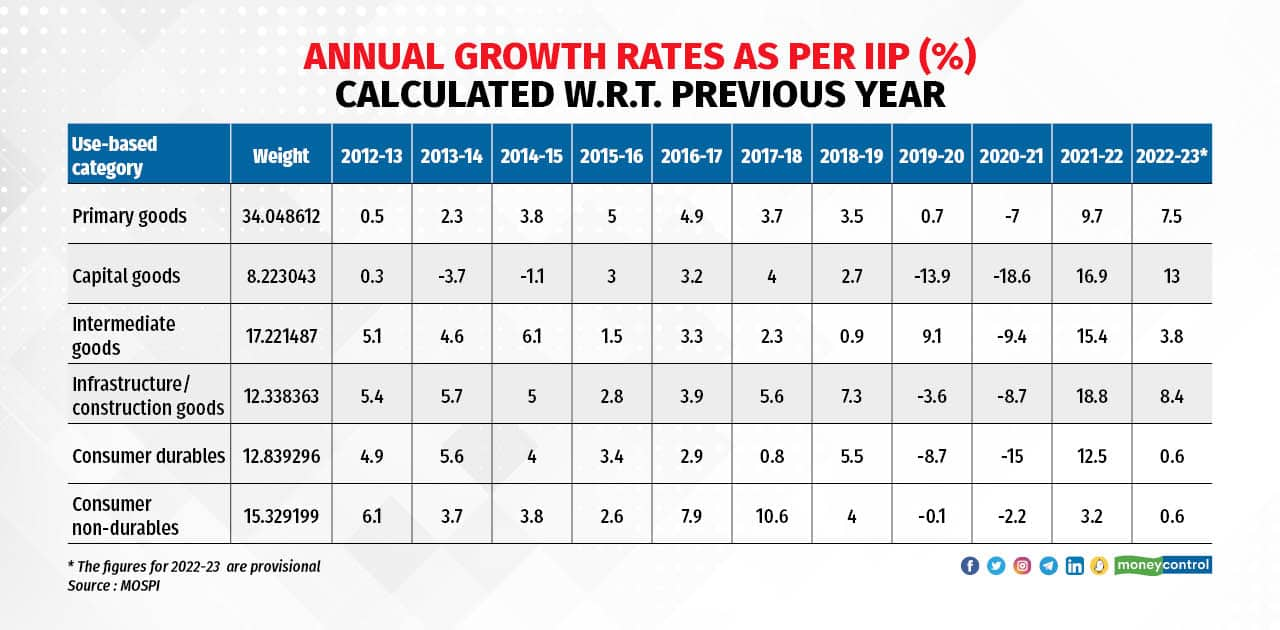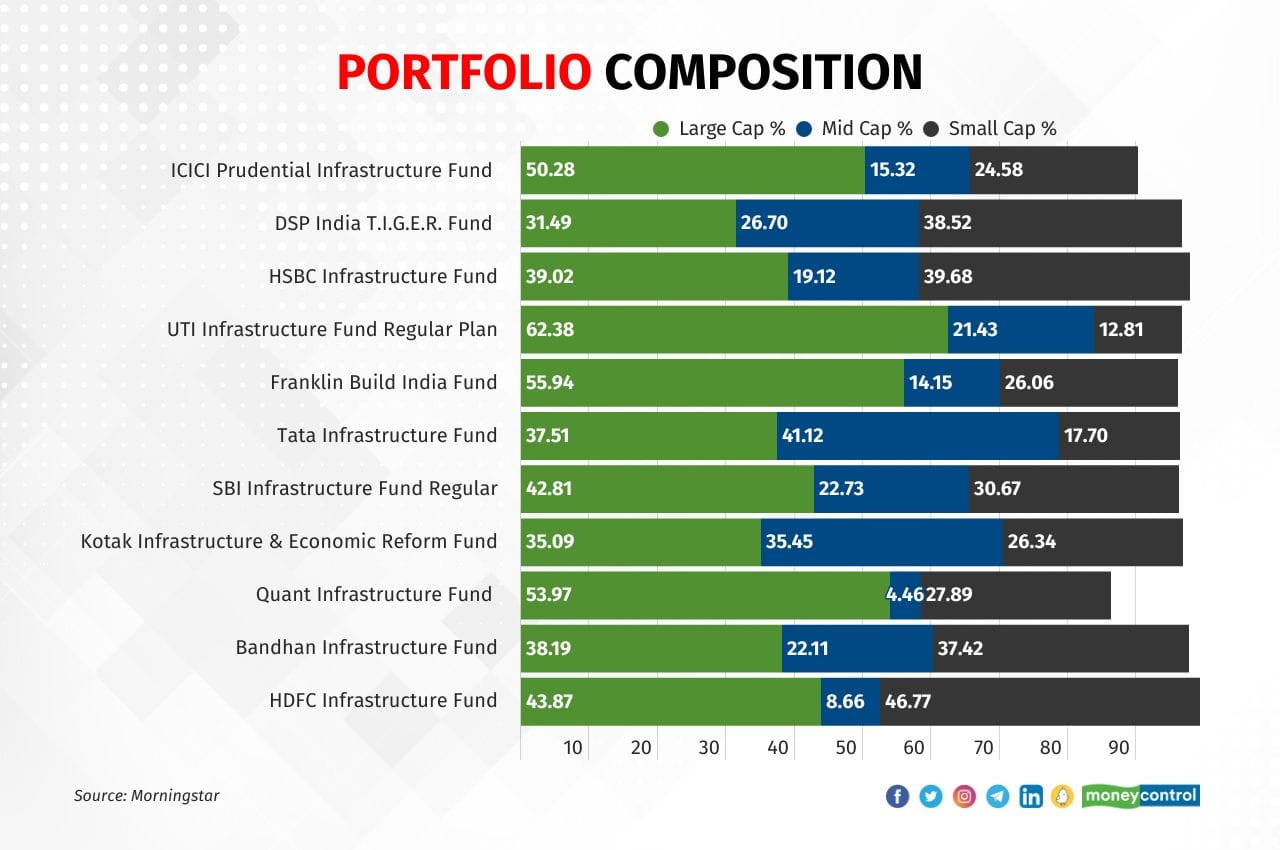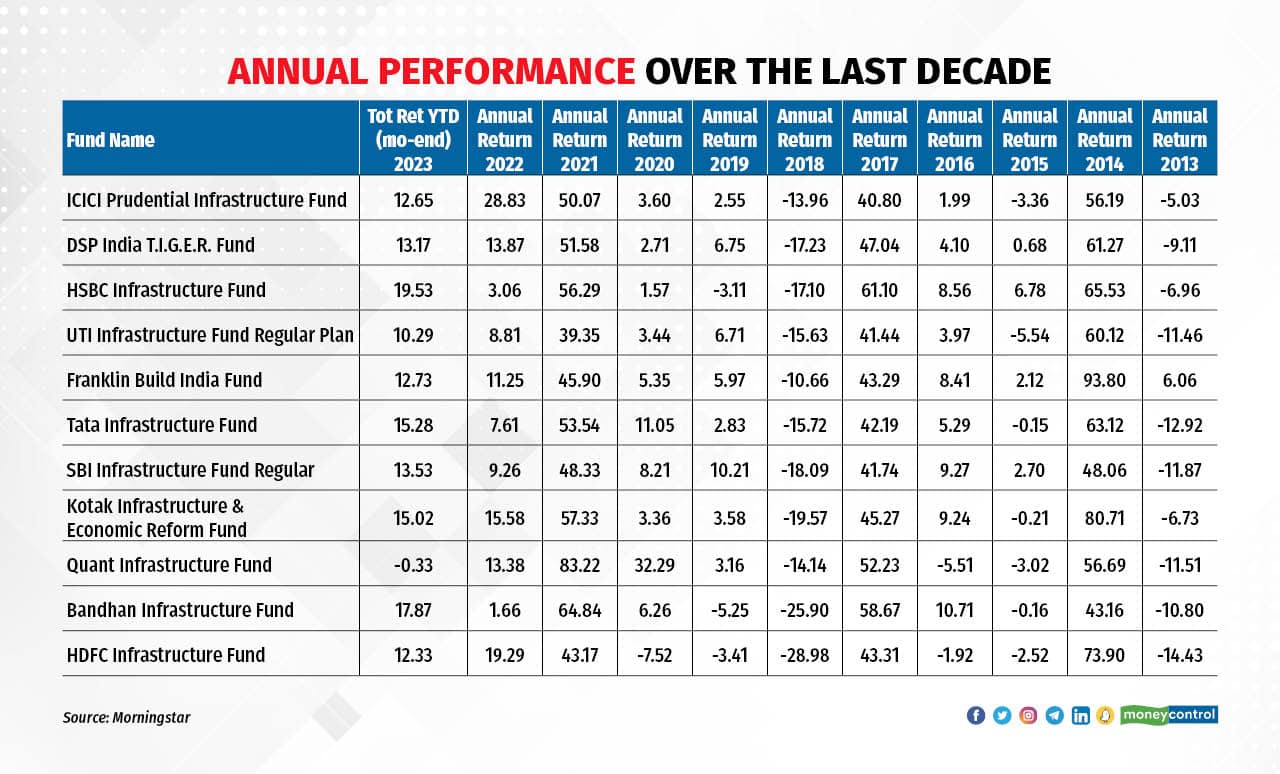



The government’s focus on infrastructure investment is reflected in the double-digit growth in capital outlay assigned to the sector in the last few years. In the Union Budget 2023-24, the capital expenditure outlay was increased to a massive Rs10 lakh crore, an over 35 per cent growth in the expenditure outlay in FY2021-22 and FY2022-23 as per the latest Economic Survey.

GBS=Gross Budgetory Support, Source: Economis Survey 2022-2023
The Survey reveals that nearly 65-70 per cent of the outlay has actually been spent in the last 2 years. This is reflected in the IIP (Index of Industrial Production) numbers if you look at the capital goods and infrastructure/construction goods category which have a roughly 20 per cent combined weightage (Refer to the table).

After negative growth in Covid, the capital goods and infrastructure goods category clocked double-digit growth for the first time since the last decade in 2021-22 and 2022-23.
To sustain this growth momentum, the government is encouraging private sector participation through initiatives like public-private partnership, National Infrastructure Pipeline and National Monetisation Pipeline. This augurs well for companies and ancillary industries involved in the creation of infrastructure – roads, railways, ports, airports, industrial plants, oil rigs, logistics, mass transport, etc.
 Bullish on India
Bullish on India
Where do infrastructure funds invest?
To participate in the India growth story, infrastructure mutual funds offer great investment opportunities. These thematic mutual funds invest across a variety of infrastructure segments like construction, cement, metals, oil & gas, capital goods, Power & power equipment, aerospace & defence, logistics, electrical equipment, industrial products, etc.
A closer look at the portfolio composition
There are 18 mutual funds in the infrastructure sector, with all of them at least a decade old. Many of them were launched between 2006 and 2008 when infrastructure companies were booming. They gradually lost steam after the Global Financial Crisis in 2008 and a slowdown in the infrastructure sector. The combined assets managed by these funds as on June 30, 2023 totalled a modest Rs 17,440 crore. Of these, the top fund by assets under management (AUM), ICICI managed assets of just Rs 2,660 crore in this category. While the infrastructure theme across the funds is the same, their portfolio composition is very much diverse. (Refer to the table below of the top 11 funds by asset size).
 infra graphics
infra graphics
Most of these funds have more than half of the average portfolio exposure to mid & small cap companies. Interestingly, exposure to small caps is higher than mid caps for the majority, barring 3-4 of them and hence the diversity in holdings.

Again, a look at the common holdings of the top 10 funds reveals that an average 25-30 percent of the companies and their weightage is similar while the rest differ. Some funds have construction & capital goods companies in their top holdings while others have major weightage to industrial products, construction materials and electrical equipment companies.
How have infrastructure funds performed in the last decade?
Infrastructure as a sector is cyclical. Revenues of infrastructure companies depend on economic growth and take a hit when the economy is down. Further, the industry is capital intensive and orders in the pipeline convert to revenues with a lag as the gestation periods of the projects are long. This is reflected in the performance of infrastructure mutual funds over the last decade.

There have been bouts of underperformance – tepid or negative returns, in 5 out of 10 years. Performance particularly took a hit 3 years in a row in 2018, 2019 and 2020. The period from January 30, 2020, to April 3, 2020, saw infrastructure funds falling by at least 35 per cent on average at the onset of the Covid period.
The funds have observed intermittent periods of sharp rises over the last decade in 2014, 2017 and 2021 with funds returning an average 40-50 percent. This recovery has usually come after a gap of 2-3 years. There is quite a stark difference in returns between the funds’ performance too. For instance, in 2021, the bottom performer, UTI Infrastructure, returned 39 percent while the top performer, Quant Infrastructure, gave a whopping 83 percent returns. Hence, the stock-picking skills of a fund manager also play an important role here amidst ample opportunities in the infrastructure space. So investors should not blindly pick these funds based on just past performance. A fund manager’s track record, portfolio composition, how volatile the fund is, how badly have they performed during periods of downfall vis-à-vis peers, etc, should be looked into before selecting a fund.
Do infrastructure funds adequately represent their benchmark?
All infrastructure funds have S&P BSE Infrastructure or Nifty Infrastructure as their benchmark. However, they are quite diverse in terms of the sectoral composition and the underlying company weightage vis-a-vis the index. For instance, the top 10 infrastructure companies have a 65 percent weight in the overall S&P BSE Infrastructure index, with most of them being large caps. Similarly, the top 10 in the Nifty Infrastructure have a combined weight of a huge 74 percent and all are large caps. In contrast, the top 10 companies in the infrastructure funds have an average weightage of 45-50 percent and not all are large caps. This is also reflected in the diverse performance of the index vis-à-vis the funds.

So should you invest in infrastructure funds?
While infrastructure funds have the potential to earn superior returns, they are a risky bet. Infrastructure cycles are marred with project delays, cost overruns, environmental compliance issues, political uncertainties, etc, which could affect the performance of the underlying companies. It is thus important to take calculated bets. Such thematic funds can be part of an investor’s satellite portfolio and should not exceed more than 10 percent of the total portfolio. Further, a lot of patience is required when investing and holding infrastructure funds. Investors should be ready to accept long periods of underperformance and high volatility. Infrastructure funds have the ability to reward patient and long-term investors who have a high-risk appetite.
Discover the latest Business News, Sensex, and Nifty updates. Obtain Personal Finance insights, tax queries, and expert opinions on Moneycontrol or download the Moneycontrol App to stay updated!
Find the best of Al News in one place, specially curated for you every weekend.
Stay on top of the latest tech trends and biggest startup news.